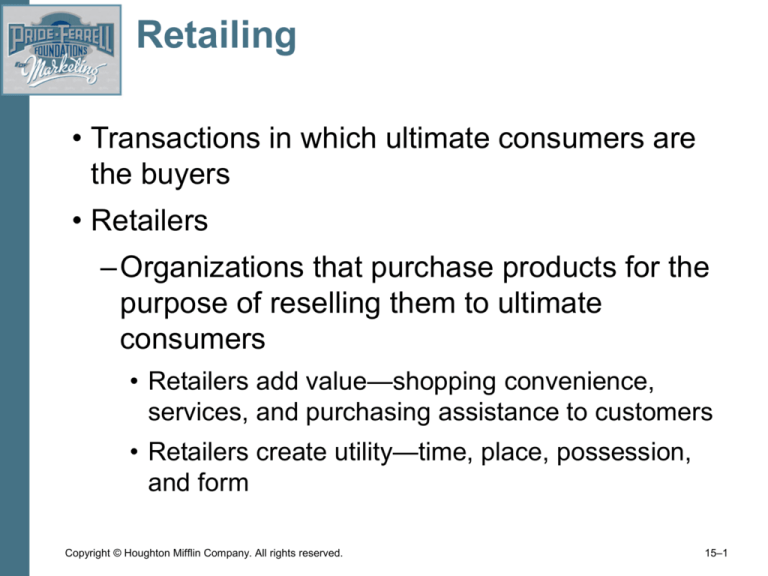
Retailing
• Transactions in which ultimate consumers are
the buyers
• Retailers
–Organizations that purchase products for the
purpose of reselling them to ultimate
consumers
• Retailers add value—shopping convenience,
services, and purchasing assistance to customers
• Retailers create utility—time, place, possession,
and form
Copyright © Houghton Mifflin Company. All rights reserved.
15–1
Table 15.1
Copyright © Houghton Mifflin Company. All rights reserved.
15–2
General-Merchandise Retailers
• Offer a variety of product lines
• Department Stores
– Large retail organizations characterized by wide
product mixes and organized into separate
departments to facilitate marketing efforts and
internal management
• Discount Stores
– Self-service, general merchandise stores offering
brand name and private brand products at low prices
• Supermarkets
– Large, self-service stores that carry a complete line
of food products, along with some nonfood products
Copyright © Houghton Mifflin Company. All rights reserved.
15–3
General-Merchandise Retailers
(cont’d)
• Superstores
– Giant retail outlets that carry food and nonfood
products found in supermarkets, as well as most
routinely purchased consumer products
• Hypermarkets
– Stores that combine supermarket and discount
shopping in one location
• Warehouse Clubs
– Large-scale, members-only establishments that
combine features of cash-and-carry wholesaling with
discount retailing
Copyright © Houghton Mifflin Company. All rights reserved.
15–4
General-Merchandise Retailers
(cont’d)
• Warehouse Showrooms
–Retail facilities in large, low-cost buildings
with large, on-premise inventories and
minimal services
• Catalog Showrooms
–A form of warehouse showroom where
consumers can shop from a catalog and
products are stored out of buyers’ reach
Copyright © Houghton Mifflin Company. All rights reserved.
15–5
Specialty Retailers
• Traditional Specialty Retailers
–Carry a narrow product mix with deep
product lines (e.g., pet supplies)
–Also called “limited-line” and “single-line”
retailers
–Have higher costs and higher margins
–Provide more product
selection (first-line brands),
product expertise, and
high levels of personal service
Copyright © Houghton Mifflin Company. All rights reserved.
15–6
Specialty Retailers (cont’d)
• Category Killers
– Concentrate on a major product category and compete
on the basis of low prices and product availability
• Off-Price Retailers
– Buy manufacturers’ seconds, overruns, returns, and
off-season merchandise for resale to consumers at
deep discounts
– Charge less than do department stores for comparable
merchandise and offer few customer services
– Have established long-term relationships with
suppliers for continuing supplies of reduced-price
goods
Copyright © Houghton Mifflin Company. All rights reserved.
15–7
Strategic Issues in Retailing
• Retail Store Location
–Factors affecting location
•
•
•
•
Intended target market
Kinds of products
Suitability of site for customer access
Characteristics of existing retail operations
• Types of Locations
–Free-standing structures
–Shopping malls and centers
–Traditional business districts
Copyright © Houghton Mifflin Company. All rights reserved.
15–8
Types of Traditional Shopping
Centers
• Neighborhood Shopping Centers
– Usually consist of several small convenience and
specialty stores
• Community Shopping Centers
– Include one or more department stores (anchors),
some specialty stores, and convenience stores
• Regional Shopping Centers
– Have the largest department
stores, the widest product mix,
and the deepest product lines
of all shopping centers
Copyright © Houghton Mifflin Company. All rights reserved.
15–9
Types of Nontraditional
Shopping Centers
• Factory Outlet Malls
– Shopping centers that feature discount and factory
outlet stores carrying traditional brand name
products
• Miniwarehouse Mall
– Loosely planned centers that lease space to retailers
running retail stores out of warehouse bays
• Nonanchored Malls
– Do not have traditional department store anchors;
instead combine off-price and category killer stores
in a “power center” format
Copyright © Houghton Mifflin Company. All rights reserved.
15–10
Strategic Issues in Retailing
• Retail Positioning
– Identifying an unserved or underserved market
segment and serving it through a strategy that
distinguishes the retailer from others in the minds of
consumers in that segment
• Store Image
– Atmospherics
• The physical elements in a store’s design that appeal to
consumers’ emotions and encourage buying
• Interior layout, colors, furnishings, and lighting
• Exterior storefront and entrance design, display windows,
and traffic congestion
Copyright © Houghton Mifflin Company. All rights reserved.
15–11
Wholesaling
• Transactions in which products are bought for
resale, for making other products, or for
general business operations
• Wholesaler
–An individual or organization that facilitates
and expedites wholesale transactions
• Handles the physical distribution
of goods
• Furnishes channel information
to facilitate and manage the
supply channel
Copyright © Houghton Mifflin Company. All rights reserved.
15–12
Major Wholesaling Functions
• Supply-Chain Management
• Promotion
• Warehousing, Shipping, and Product Handling
• Inventory Control and Data Processing
• Risk Taking
• Financing and Budgeting
• Marketing Research and Information Systems
Copyright © Houghton Mifflin Company. All rights reserved.
15–13
Services Provided by
Wholesalers
• Serve as an extension of the producer’s sales
force through contact with suppliers and retailers
• Lend financial assistance for the distribution
channel
• Transport and warehouse inventories
• Assume credit risks of buyers/customers
• Purchase producers’ entire output: convert
producer’s output immediately to working capital
• Channel information from and to sellers and
buyers
Copyright © Houghton Mifflin Company. All rights reserved.
15–14
Types of Wholesalers
• Merchant Wholesalers
–Independently owned businesses that take
title to goods, assume ownership risks, and
buy and resell products to other wholesalers,
business customers, or retailers
•
•
•
•
•
•
Provide market coverage
Make sales contacts
Store inventory
Handle orders
Collect market information
Furnish customer support
Copyright © Houghton Mifflin Company. All rights reserved.
15–15
Types of Wholesalers
• Manufacturers’ Sales Branches and Offices
–Sales branches
• Manufacturer-owned intermediaries that sell
products and provide support services to the
manufacturer’s sales force
–Sales offices
• Manufacturer-owned operations
that provide services normally
associated with agents
Copyright © Houghton Mifflin Company. All rights reserved.
15–16


